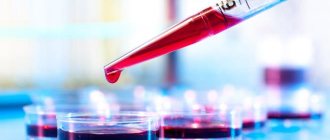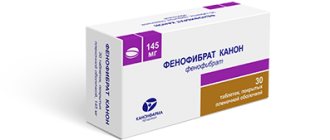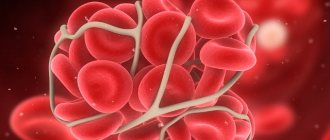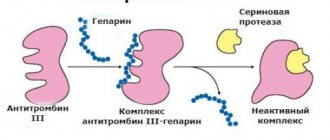When a cardiologist issues a referral for a blood test for homocysteine, 8 out of 10 patients have questions about what this indicator is and what it affects. Homocysteine is a low molecular weight organic compound responsible for biochemical and metabolic processes.
Unlike most similar components, it cannot be taken into the body with food. Homocysteine is produced by another amino acid called methionine. Violation of the synthesis of the component leads to the development of various pathologies, including an increased risk of developing cardiovascular diseases, stroke and the progression of Alzheimer's disease.
What is homocysteine?
When eating protein foods, the body receives methionine, an essential amino acid. When protein is processed, another amino acid is formed from this compound - homocysteine, which is its by-product. Normally, it is quickly converted into other, non-hazardous substances.
In order for this conversion process to take place, a sufficient amount of vitamins B6, B12 and folic acid is necessary. Otherwise, the amount of homocysteine in the body increases and leads to the development of various pathologies.
Homocysteine test
Blood tests for homocysteine are given according to indications. These include risk factors for elevated amino acid levels:
- dysfunctions of the cardiovascular system;
- arterial, venous thrombosis;
- heredity in the form of heart attacks or strokes;
- diabetes;
- renal failure;
- endocrine, genetic diseases;
- old age after 60 years;
- pregnancy;
- alcohol, drug addiction;
- previous gastric surgery;
- Alzheimer's disease, senile dementia;
- homocystinuria is a disease caused by a disorder of homocysteine metabolism;
- lack of folate, B vitamins, excess methionine;
- long-term deficiency of thyroid hormones, hypothyroidism, deficiency of sex hormones;
- psoriasis;
- hyperproliferative processes;
- treatment with immunosuppressants, antiepileptics, sulfur-containing drugs, antiphospholipid drugs, antimetabolites (Methotrexate, Cyclosporine, Phenytoin, Eufillin, Metformin);
- smoking, excessive caffeine intake.
An increase in homocysteine in the blood may not manifest itself in any way, but leads to the development of dangerous diseases. To check, a diagnosis is carried out: a person donates blood from a vein:
- It is taken on an empty stomach.
- The day before, the patient is instructed to exclude fatty and meat foods from the diet, and only water is allowed to be taken from the liquid.
- Alcohol is strictly prohibited before the analysis.
- 20 minutes before the plasma test, the patient must be provided with complete emotional and physical rest.
The doctor also has the right to conduct a biochemical analysis with a methionine load - a second time, blood is taken after a meal, after which the two indicators are compared. You can also check freshly excreted urine - in a healthy person it does not contain homocysteine. If the analysis showed the presence of an amino acid at a level above 1 mg/ml, this indicates the pathological development of diseases. It is important to take freshly excreted urine for analysis, because over time the amino acid is converted to a salt and cannot be detected, which will complicate the diagnosis.
Articles on the topic
- Omnik - instructions and mechanism of action, contraindications, side effects, dosage regimen and analogues
- What are antibodies in the blood - why are they produced and what do they affect in the body, determination test
- Anticholinergics - what they are and when they are prescribed, classification based on the principle of effect, contraindications
Functions in the body
Homocysteine (the norm for women depends on age) gradually increases throughout life. This substance is necessary for the normal restoration of body cells and their development. All cytological structures contain this compound in small quantities.
With a normal concentration of homocysteine in the blood, blood vessels are protected from the formation of blood clots and the appearance of atherosclerotic plaques. The substance also indirectly normalizes blood flow, providing nutrition to organs and systems at the cellular level.
If the amount of the compound is increased, a narrowing of the lumen of the arteries is observed, while nutrients and oxygen reach the internal organs in insufficient quantities, disrupting their functions. Experts say that for an elderly person, excess homocysteine can be more dangerous than high blood pressure or high cholesterol.
In addition, scientists have found that high levels of the amino acid can cause weakening of mental abilities due to the likelihood of damage to blood vessels in the brain.
Patients whose amount of amino acid is increased by 2-3 times are at risk for developing senile dementia and Alzheimer's disease, which is characterized by a gradual loss of mental abilities.
Homocysteine (the norm for women changes during pregnancy) should decrease during pregnancy, thereby promoting normal placental blood circulation. But in some cases, high levels of the substance remain, while it freely penetrates the placenta and provokes damage to the fetus.
Causes, consequences and treatment of increased homocysteine
An increase in homocysteine levels in the blood is called hyperhomocysteinemia. Homocysteine, accumulating in blood vessels in excess amounts, has a toxic effect on the inner lining of blood vessels (intima). In places where damage has occurred, calcium or cholesterol plaques are deposited on the intima. The lumen of the vessels decreases, and blood clots form in them. The supply of blood and nutrients to organs and tissues is disrupted. An increase in homocysteine concentration by 5 µmol/l increases the risk of vascular damage in men by 60; in women - by 80%.
There are several known causes of increased homocysteine:
- Lack of B vitamins and folic acid in the body;
- Impaired kidney function;
- Drinking alcohol and smoking;
- Drinking excessive amounts of coffee;
- Homocystinuria (hereditary disease);
- Sedentary lifestyle;
- Thyroid diseases.
- Hormone-dependent diseases.
An increase in homocysteine concentration can lead to the development of the following diseases:
- Alzheimer's disease;
- Senile dementia;
- Myocardial infarction;
- Thrombosis;
- Heart failure;
- Atherosclerosis.
When hyperhomocysteinemia is detected, doctors at the Yusupov Hospital carry out complex therapy. The patient's diet includes foods rich in vitamins B1, B6, B12 and folic acid: vegetables, legumes, cereals, nuts, spinach and seafood. Limit foods containing methionine - meat, eggs, dairy products. If intestinal function is impaired, vitamins are administered intramuscularly.
Doctors prescribe blood thinners (acetylsalicylic acid) to patients with elevated homocysteine levels. Rehabilitation specialists are developing a special set of physical exercises.
To determine homocysteine levels, blood is taken from a vein. Blood is drawn on an empty stomach. The patient is recommended to avoid taking fatty meat foods, eggs, milk and dairy products on the eve of the study.
Reduced rate during pregnancy
If homocysteine levels have decreased at the beginning of pregnancy, this is normal. The body is rebuilt to ensure comfortable development of the fetus. Sometimes the homocysteine level may be too low, and this is also considered acceptable. How to increase homocysteine during pregnancy? It is recommended to lead an active lifestyle and consume foods rich in nutrients.
What physical activity is recommended for pregnant women? It is necessary to be in the fresh air every day, and it is also useful to visit a swimming pool. It would be enough. There are also sets of gymnastic exercises designed specifically for pregnant women.
So, moderate physical activity, the use of vitamin complexes and natural products are the basis for homocysteine levels during pregnancy.
Note! If coffee is contraindicated if you have high homocysteine levels, if your level is low, it is recommended to drink a cup of the drink daily.
Normal indicators
Homocysteine levels depend on the gender and age of the patient. Also, the values change during the period of bearing a child.
Homocysteine above normal is dangerous for women and men, because is an indicator of arterial disease
With age, the concentration of the substance increases, but if its amount does not exceed the upper limit of normal, then there is no cause for concern.
For adult women
In women, the normal level of the substance in the blood should be 4.6-12.44 µmol/l. With age, its amount increases, and in the fairer sex this process occurs faster than in men. The reason is decreased kidney function.
For pregnant
Homocysteine (the norm for women depends on the period of gestation) decreases during pregnancy. The lowest concentration of the amino acid is observed in the early stages of gestation, increasing by the third trimester.
Homocysteine levels depending on the stage of pregnancy:
| Trimester | Amount of substance in blood, µmol/l |
| I | 4-12 |
| II | 5,7-12,4 |
| III | 6-12 |
After birth, the indicators return to normal within a few days. If a pregnant woman's homocysteine level is elevated, this may cause the baby to be born underweight.
These children have reduced immunity, so they often get sick. The reason is the ability of the fetus to absorb the amino acid while in the womb, which affects its development. More severe complications are also possible - stillbirth, fetal hypoxia or spontaneous abortion.
The importance of homocysteine...
The average normal values of homocysteine in the blood of a healthy adult are 10 - 11 µmol/l, in children, regardless of gender - up to 5 µmol/l, in adolescents who have begun puberty - up to 6 (girls) - 7 (boys) µmol/l .
In the blood, this non-protein sulfur-containing amino acid (homocysteine) can be present in three molecular variants, but most often (up to 80%) it can be found in the form of a compound associated with plasma proteins (mainly albumin). A certain genetic pathology, as well as some acquired diseases that lead to enzyme defects and a decrease in the level of vitamins, cause a violation of the metabolism of this metabolic product. This leads to its excessive accumulation in cells, intercellular and interstitial fluid and, finally, in plasma.
High homocysteine creates a cytotoxic effect, which results in cell death, and also negatively affects the vascular walls, since, by loosening their surface, it creates conditions for attracting “bad” cholesterol (LDL, VLDL) and calcium salts, which are suitable materials, to the sites of endothelial damage for the “construction” of atherosclerotic plaques. Thus, this substance takes part in the development of atherosclerosis, enhances platelet aggregation and promotes the formation of blood clots. In this regard, determination of the concentration of this amino acid, together with other laboratory indicators (lipid spectrum, fibrinogen, CRP) is used to assess the degree of risk of developing cardiovascular pathology.
A blood test for homocysteine is usually not used during a routine examination (medical examination, medical examination), so most people have not even heard of its existence. But many people learn about it when planning the birth of a child. During pregnancy (in a certain category of women), increased homocysteine levels acquire particular clinical significance.
If the concentration of hymocysteine is increased during pregnancy, there is a risk of spontaneous miscarriages, premature birth, thromboembolism (venous), preeclampsia and eclampsia in the pregnant woman, as well as various abnormalities of intrauterine development as a result of oxygen starvation of the fetus.
Reasons for the increase
Hyperhomocysteinemia (increased amino acid content) can be caused by various reasons. The disorder develops as a result of certain diseases and improper lifestyle. The pathology can also be hereditary.
Lack of vitamins
The main reason for elevated homocysteine levels is a lack of vitamins. This condition can occur with malabsorption syndrome, which is characterized by impaired absorption of nutrients, in this case, folic acid and B vitamins.
Also, the absorption of vitamins worsens in patients suffering from:
- atrophic gastritis;
- chronic colitis;
- Crohn's disease;
- nonspecific ulcerative colitis.
Pathology can occur after surgical interventions on the gastrointestinal tract or when a malignant tumor spreads in the abdominal cavity.
Homocystinuria
A hereditary disease that causes an increase in homocysteine is homocystinuria. The pathology is characterized by impaired absorption of methionine. The result is an increase in the concentration of homocysteine, and the level of other components also increases.
In this case, the nervous, musculoskeletal, and cardiovascular systems suffer, which is accompanied by:
- mental retardation and mental retardation;
- convulsive seizures;
- ophthalmological pathologies;
- abnormalities of the skeletal system;
- thromboembolism, thrombosis;
- high blood pressure.
Vascular problems
In people who suffer from atherosclerosis, have had a stroke or heart attack, or have ischemic pathologies of the vessels of the lower extremities, the level of the amino acid in the blood is increased. In addition, many studies have shown that after treatment that reduces homocysteine concentrations, the risk of developing these pathologies also decreases.
Obesity
One of the factors contributing to increased levels of the substance in the blood is excess weight.
Even in the initial stages of obesity, test results deviate from the norm.
Diabetes
In patients with type 1 diabetes mellitus, the amount of homocysteine is within normal limits or even reduced. If the disease is complicated by nephropathy, the level of the substance increases.
Among the causes of the disorder, an increased concentration of glucose is also noted, which leads to a deficiency of B vitamins, which are involved in amino acid metabolism.
Taking medications
Taking certain medications can help increase homocysteine levels:
- Methotrexate;
- Metformin;
- H2 receptor antagonists;
- Eufillina;
- hormonal contraceptives.
Drugs used in the treatment of psoriasis can neutralize the effect of folic acid, and when using anticonvulsants and immunosuppressive drugs, B vitamins are broken down, which leads to an increase in the level of the amino acid.
Other factors
There are other factors that can cause a violation:
- hormone imbalances;
- sedentary lifestyle;
- bad habits;
- excessive coffee consumption (more than 6 cups per day);
- kidney diseases.
Should I be concerned about elevated homocysteine levels?
Homocysteine is a very toxic substance. Its excess in the blood (homocysteinemia) causes vascular damage, which in turn leads to the development of many serious diseases. Take, for example, atherosclerosis. Homocysteinemia is one of the main factors in the development of this difficult-to-treat disease. The mechanism of its appearance is as follows: the walls of the vessels through which blood flows are damaged due to excess homocysteine. Cholesterol plaques then begin to form in the areas where the damage occurred. Over time, they turn into blood clots. This is how atherosclerosis appears.
In addition, a large number of serious illnesses of the cardiovascular system can increase homocysteine levels. Due to the growth of the amino acid, Alzheimer's disease develops, senile dementia, myocardial infarction and heart failure occur. So you really should be afraid of homocysteinemia.
Possible symptoms of increased
The increase in homocysteine levels usually does not manifest itself in any way. A person develops signs of the pathology that caused the disorder.
Since most often deviations occur due to a deficiency of B vitamins, the condition can manifest itself:
- pale skin;
- tingling in the limbs;
- dizziness;
- unstable mood.
With folic acid deficiency, the patient will suffer from:
- fatigue;
- ulcers on the oral mucosa;
- swelling of the tongue.
If both elements are missing, the condition manifests itself:
- erratic movements;
- shortness of breath;
- arrhythmia;
- confusion;
- memory problems;
- weight loss.
During the period of bearing a baby, there are clear signs of a disorder. Amino acid deficiency manifests itself:
- peripheral edema;
- decreased daily diuresis;
- overweight.
Reasons for the decline
A decrease in homocysteine levels is rare. Usually this is not a sign of any pathology and can be corrected with proper nutrition. However, sometimes this condition indicates problems in the body.
Genetic disorders
A deficiency of the substance is characteristic of genomic pathologies. For example, amino acid deficiency is observed in children with Down syndrome.
Less commonly, the disorder occurs in other pathologies, such as tetralogy of Fallot (improper formation of cardiac structures) or other congenital heart defects. Conservative therapy in such cases is powerless, since the deviations are genetic. The only treatment option is surgery.
Pregnancy
Reduced homocysteine levels in pregnant women are normal. After conception, the amount of the substance decreases and then gradually begins to increase. The indicators finally return to normal some time after birth.
Hormonal problems
Lack of amino acid is characteristic of a disease such as hyperthyroidism. The pathology has clear manifestations.
Symptoms of thyroid disease in women, namely hypothyroidism.
The patient has:
- headache;
- nausea;
- weakness;
- disturbances in the functioning of the cardiovascular system;
- jumps in temperature and pressure.
With this disease, the substance is processed at an accelerated pace and does not have time to be synthesized, so its level decreases.
It is necessary to begin treatment as soon as possible by contacting an endocrinologist. Typically, iodine preparations are used as therapy. In addition, the patient may be recommended a special diet. In case of endemic form of the disease, it is advisable to change your place of residence.
Oncology
The amino acid concentration begins to decrease with the development of the pathological process. With further progression of the disease, the homocysteine level drops even more, since the malignant neoplasm is able to take most of the amino acids for growth and development.
Surgery is usually recommended as treatment, followed by chemotherapy and radiation therapy if necessary.
Other factors
Another cause of decreased levels of the substance in the blood is multiple sclerosis. Often, it is a deviation in the tests that is the first sign of the development of a pathological process. Additional studies are recommended to confirm the diagnosis.
The disorder can be provoked by taking certain medications (Penicillamine, Acetylcysteine, Betaine). Also, the concentration of the substance may be reduced in a person who takes folic acid and B vitamins daily.
When an analysis is prescribed, preparation for the study
It is recommended to check your homocysteine level:
- pregnant women;
- patients with elevated cholesterol levels;
- those who suffer from hypertension and coronary heart disease;
- people prone to blood clots;
- patients over 40 years of age who have had a stroke or heart attack;
- diabetics with vascular complications;
- patients with endocrine and genetic pathologies;
- suffering from alcoholism or drug addiction.
Taking an analysis in such cases is a mandatory requirement. This allows you to make or clarify a diagnosis and calculate all the risks.
Homocysteine is an important indicator for women planning pregnancy. An increased amount of amino acid is very dangerous for the fetus. Therefore, if a deviation from the norm is detected, the doctor will recommend taking blood thinning medications at the planning stage.
Before conducting the study, you need to prepare in order to get a reliable result:
- On the eve of the test, you should not eat food with a high protein content. After 19.00, consumption of fish, meat, eggs, and dairy products is prohibited. Otherwise, you may get a false positive result;
- Stop taking medications a few days before the test, if possible. If medications are vital, you should notify your doctor about their use before taking the test;
- the day before the analysis, avoid increased physical activity.
Indications for analysis
The doctor will send the patient to test the level of homocysteine in the blood to:
- assess the risk of developing atherosclerotic damage to the vascular wall;
- confirm homocysteinuria caused by a defect in one of the homocysteine metabolic enzymes;
- indirectly assess the amount of cobalamin and folic acid, especially in people with poor nutrition.
Also, the analysis should be carried out if a heart attack or stroke occurs unexpectedly without any previous conditions or predispositions.
Conducting research
The study is carried out on an empty stomach. In the morning before taking the test, you can only drink a small amount of water. Biomaterial is taken from a vein. To do this, the laboratory assistant places a tourniquet on the forearm and secures it, while the patient actively works with his fist to make it easier to detect the vein. After 2 ml of blood is collected, it is taken to the laboratory for analysis.
If deviations are detected, depending on the expected diagnosis, it may additionally be necessary to:
- ultrasound examination of the gastrointestinal tract;
- chest x-ray;
- brain puncture;
- CT, MRI with contrast.
How to reduce homocysteine to normal?
Homocysteine (the norm for women depends on many factors), with minor deviations in the analysis, can be reduced by adjusting the menu and lifestyle.
To do this you need:
- to refuse from bad habits. Due to the influence of cyanide, which is contained in cigarette smoke, the concentration of B vitamins in the blood decreases, which helps to increase the level of the amino acid. This also applies to people with alcohol addiction, whose amount of B vitamins is also reduced;
- reduce your coffee consumption. Caffeine inhibits the enzyme methionine synthase, which causes a disorder;
- reduce the amount of protein foods. It is recommended to have vegetarian days from time to time. Meat and offal, especially fatty varieties, should be present in the diet in small quantities. It is allowed to consume 120 g of meat per day. You should also increase the amount of foods containing B vitamins.
This element is present in:
- leafy greens;
- walnuts and almonds;
- watermelons;
- peaches;
- citrus fruits;
- buckwheat;
- oatmeal;
- tomatoes;
- cod liver;
- women who are actively involved in sports , and especially if they are planning to conceive, are advised to reduce their loads and switch to more gentle activities.
If general recommendations do not help reduce amino acid levels, a specialist may recommend taking medications. The basic medications that are prescribed for this disorder are B vitamins. They are administered by injection. After the level of the substance is normalized, it is recommended to take multivitamins in courses.
To compensate for the lack of folic acid, it is recommended to use the drug 5MTHF. The advantage of this remedy is that its use does not mask the signs of the disease as symptoms of B vitamin deficiency. Another effective remedy for solving the problem is Methyl B-12.
Sometimes antiplatelet agents (Clexane, Fragmin) are also prescribed, which are necessary to improve the rheological (reflecting fluidity) properties of blood. You cannot prescribe such medications yourself, as various side effects may occur when taking them.
If the cause of a violation in the level of a substance is a certain pathology, the specialist recommends the use of means and methods to eliminate it.
Diet for high homocysteine
We have already found out that the way homocysteine enters the body is through the consumption of animal proteins, from which, during synthesis, another amino acid, methionine, is first formed, and then it is converted into homocysteine.
Thus, any dietary therapy should be aimed, on the one hand, at limiting the consumption of animal proteins, and on the other, at enriching the diet with foods rich in B vitamins, which are cofactors for the conversion of homocysteine.
So what can you eat and what can’t you eat? Which products are allowed and which are prohibited?
What should you limit yourself to?
The following are subject to restrictions (in order, from largest to smallest):
1. Animal products rich in methionine, namely:
- red meat;
- chicken;
- turkey;
- pork;
6-8 hours after eating a protein-rich meal, the level of homocyteine in the blood plasma increases by 10-15%.
2. Dairy products based on animal milk:
- milk
- cheese
- cottage cheese
- dairy products
Avoid heavy protein dinners, such as those consisting of cottage cheese and sour cream, as they lead to high homocysteine levels the next morning.
3. Legumes in large quantities. Although they are a source of B vitamins, and beans are especially rich in folic acid, you should not overdose.
The Arabs say that “too many legumes thickens the blood.” From a scientific point of view, the same process of “slaging” the body with homocysteine occurs as with the abuse of meat.
4. Harmful combinations of meat and legumes in one meal. Different types of protein require different “approaches” of the body to process it. In the case of mixing, we add trouble to our gastrointestinal tract and at first we only observe problems of indigestion, which can later continue with vascular complications.
Methionine is not evil in itself. It becomes dangerous in case of overdose and folate cycle disorders.
If the latter (folate cycle disorders) is not genetic in nature, then an adequate range of homocysteine levels can be achieved with a balanced diet, with the obligatory presence of foods rich in vitamins B1, B6, B9 and B12.
8 Healthy Food Groups
Include in your diet on a regular basis:
- Liver, eggs, fish. The latter, by the way, can, in special cases, completely replace meat, since it has been proven that when switching to a fish-vegan diet, people achieve a reduction in homocysteine levels without additional vitamin supplements by 13%. Liver and eggs, as well as red meat, in addition to being rich in protein, are also sources of B vitamins, and especially B12, which is not found in any plant product. Therefore, a pure vegan diet is not recommended for people at risk, especially pregnant women and the elderly.
- Spinach, parsley, roccola, broccoli, tomatoes, any other vegetables. Vegetables and greens are rich in B vitamins, they contain methyl group donors and have limited methionine content. Follow the rule: the more intense the green color, the more folic acid it contains. And the French generally call spinach the king of vegetables!
- Nuts, especially walnuts and peanuts. Different nuts contain different B vitamins, so it is optimal to regularly consume mixtures of different nuts.
- Cereals. Have breakfasts from various mixtures of cereals, especially fortified ones, and also cook porridge from unprocessed cereals. Buckwheat and oatmeal are extremely healthy.
- Cereal sprouts. Sprouted grains contain the largest amount of vitamin B and many other useful elements. Therefore, do not neglect the opportunity to enrich your diet with this inexpensive delicacy.
- Yeast. They can be added as a supplement to any food that contains some liquid. The same applies to bran.
- Potatoes and its varieties (yams and others). It contains a lot of vitamin B6.
- Rye bread. It is this type of bread that contains large amounts of vitamin B9, or folic acid.
Listen to your body! It is designed in an incredibly wise way, and has an amazing ability to self-heal. Excessive eating and bad habits lead to the abuse of this function, as a result of which people have to resort to various mind-boggling artificial therapies.
How to raise homocysteine to normal?
In most cases, a low amino acid level detected during testing is not a pathology and does not require correction. If the deviation arose due to taking medications, then after they are discontinued the condition returns to normal.
Treatment will only be needed if the disorder is caused by a specific disease. The indicators will return to normal after he is cured.
Homocysteine is an amino acid that is necessary for cell regeneration, synthesis and development. However, an increase in the level of this substance in the blood of women is a dangerous symptom that requires attention. When it accumulates excessively, the walls of blood vessels are damaged, their lumen narrows, and blood clots form.
The consequences of such processes can be very serious, even fatal. It is especially important to evaluate the amount of the compound in the blood of pregnant women, as well as during the period of planning conception, in order to avoid problems with bearing the fetus.
Homocysteine during pregnancy and its planning
According to many medical data, when planning pregnancy, homocysteine levels should be between 10 and 11 µmol/l.
At the planning stage, it is very important to know the level of this value, since a lot depends on the concentration of this element, for example:
- When carrying a baby, every woman experiences a decrease in this indicator, which is a completely normal factor, therefore, before conception, care must be taken to ensure that its level is within normal limits.
- If at the time of conception or shortly before this event the concentration of the substance deviates from the norm, this can affect blood circulation in the placenta and lead to disturbances in the development of the baby and the formation of its organs.
- If, based on the results of tests at the planning stage, the doctor discovers deviations from homocysteine standards, he can postpone the date of expected conception and prescribe a special diet, as well as the use of certain medications to correct the indicator. It is important that at the time of conception the level of this substance is normal.
To prevent a woman from having unnecessary problems with the development of the baby and blood circulation in the placenta during pregnancy, it is important to find out the level of homocysteine at the planning stage, so you should not refuse to conduct additional tests.











